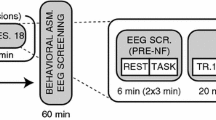Abstract
Six children were provided with long-term biofeedback and academic treatment for attention deficit disorders. Their symptoms were primarily specific learning disabilities, and, in some cases, there were varying degrees of hyperkinesis. The training consisted of two sessions per week for 10 to 27 months, with a gradual phase-out. Feedback was provided for either increasing 12-to 15-Hz SMR or 16- to 20-Hz beta activity. Inhibit circuits were employed for blocking the SMR or beta when either gross movement, excessive EMG, or theta (4–8 Hz) activity was present. Treatment also consisted of combining the biofeedback with academic training, including reading, arithmetic, and spatial tasks to improve their attention. All children increased SMR or beta and decreased slow EEG and EMG activity. Changes could be seen in their power spectra after training in terms of increased beta and decreased slow activity. All six children demonstrated considerable improvement in their schoolwork in terms of grades or achievement test scores. None of the children are currently on any medications for hyperkinetic behavior. The results indicate that EEG biofeedback training, if applied comprehensively, can be highly effective in helping to remediate children who are experiencing attention deficit disorders.
Similar content being viewed by others
References
Cobb, D. E., & Evans, J. R. (1981). The use of biofeedback techniques with school-aged children exhibiting behavioral and/or learning problems.Journal of Abnormal Child Psychology, 9, 251–281.
Lubar, J. F. (1983). Electroencephalographic biofeedback and neurological applications. In J. V. Basmajian (Ed.),Biofeedback: Principles and practice (pp. 37–61). Baltimore: Williams and Wilkins.
Lubar, J. F. (in press). Applications of operant conditioning of the EEG for the management of epileptic seizures. In N. Birbaumen (Ed.),Self-regulation of the brain and behavior. (pp. 107–125). Heidelberg: Springer.
Lubar, J. F., Bianchini, K. J., Calhoun, W. I., Lambert, E. W., Brody, Z. H., & Shabsin, H. S. (1984).Learning disabled and non-disabled children: Spectral analysis of EEG differences. Submitted for publication.
Lubar, J. F., & Deering, W. M. (1981).Behavioral approaches to neurology. New York: Academic Press.
Lubar, J. F., & Shouse, M. N. (1976). EEG and behavioral changes in a hyperactive child concurrent with training of the sensorimotor rhythmn (SMR). A preliminary report.Biofeedback and Self-Regulation, 1, 293–306.
Lubar, J. F., & Shouse, M. N. (1977). Use of biofeedback in the treatment of seizure disorders and hyperactivity. In B. B. Lahey & A. E. Kadzin (Eds.),Advances in child clinical psychology. New York: Plenum Press.
Lubar, J. O. (1982, March 5–8).The use of EEG analysis for assessing the effectiveness of biofeedback for treating learning disabled and children with MBD syndrome. Paper presented at the 13th annual meeting of the Biofeedback Society of America, Chicago.
Muehl, S., Knott, J. R., & Benton, A. L. (1965). EEG abnormality and psychological test performance in reading disability.Cortex, 1, 434–439.
Russell, H., & Carter, J. (1982, March 5–8).EEG and EMG hemispheric specific biofeedback. Paper presented at the 13th annual meeting of the Biofeedback Society in America, Chicago.
Satterfield, J. H. (1973). EEG issues in children with minimal brain dysfunction.Seminars in Psychiatry, 5, 35–46.
Shouse, M. N., & Lubar, J. F. (1978). Physiological basis of hyperkinesis treated with methlyphenidate.Pediatrics, 3, 343–351.
Shouse, M. N., & Lubar, J. F. (1979). Sensorimotor rhythmn (SMR) operant conditioning and methlyphenidate in the treatment of hyperkinesis.Biofeedback and Self-Regulation, 4, 299–311.
Sterman, M. G., & Macdonald, L. R. (1978). Effects of central cortical EEG feedback training on seizure incidence in poorly controlled epileptics.Epilepsia, 159, 207–222.
Sterman, M. G., Macdonald, L. R., & Stone, R. K. (1974). Biofeedback training of the sensorimotor electroencephalographic rhythm in man: Effects on epilepsy.Epilepsia, 15, 395–416.
Sterman, M. B., & Wywricka, W. (1967). EEG correlates of sleep: Evidence for separate forebrain substrates.Brain Research, 6, 143–163.
Tansey, M. A., & Bruner, R. L. (1983). EMG and EEG biofeedback training in the treatment of a 10-year-old hyperactive boy with a developmental reading disorder.Biofeedback and Self Regulation, 8, 25–37.
Author information
Authors and Affiliations
Additional information
The authors would like to thank Mr. Kevin Bianchini for his assistance in this study.
Rights and permissions
About this article
Cite this article
Lubar, J.O., Lubar, J.F. Electroencephalographic biofeedback of SMR and beta for treatment of attention deficit disorders in a clinical setting. Biofeedback and Self-Regulation 9, 1–23 (1984). https://doi.org/10.1007/BF00998842
Issue Date:
DOI: https://doi.org/10.1007/BF00998842




